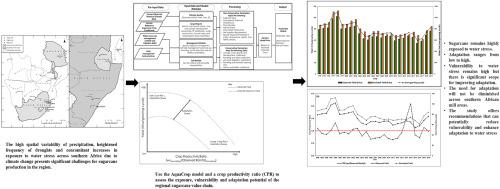An assessment of the vulnerability and adaptation potential of sugarcane production to water stress, southern Africa
Abstract
The high spatial variability of precipitation, heightened frequency of droughts and concomitant increases in exposure to water stress across southern Africa due to climate change, presents significant challenges for sugarcane production and the regional sugarcane production value chain. While production has intensified in the past few decades, yields have declined due to increased climatic variability and agronomic management approaches. Increased precipitation variability has enhanced sugarcane vulnerability to water stress and is likely to negatively affect yields. Combining crop simulations and relationships between sugarcane water use and observed rainfall, we introduce a crop productivity ratio (CPR) which assesses sugarcane water stress for six sugarcane mills across southern Africa. The CPR and simulation results were used to assess the adaptation potential or ‘space’ for mill areas that have varying rates of exposure and abilities to adapt to water stress. Simulation results were used to determine the long-term adaption potential of mill areas and to surmise the causes of yield declines. The results were used to offer recommendations to reduce vulnerabilities and enhance adaptation to water stress. We conclude that the amplification of inter-annual precipitation variability will enhance the exposure of sugarcane to water stress and require adaptation interventions. Adapting to external shocks is a multifaceted exercise that requires a holistic approach that includes every aspect of the sugarcane value chain.


 求助内容:
求助内容: 应助结果提醒方式:
应助结果提醒方式:


